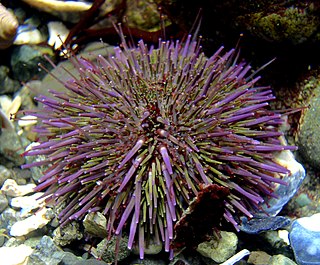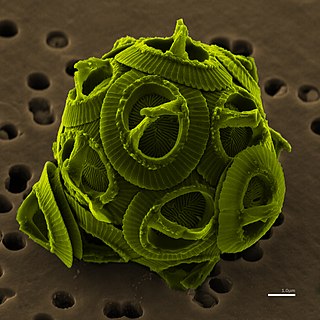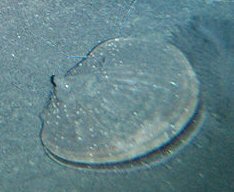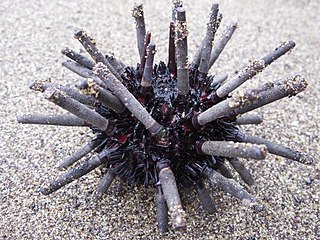The eelpouts are the ray-finned fish family Zoarcidae. As the common name suggests, they are somewhat eel-like in appearance. All of the 300 species are marine and mostly bottom-dwelling, some at great depths. Eelpouts are predominantly found in the Northern Hemisphere. The Arctic, north Pacific and north Atlantic oceans have the highest concentration of species; however, species are found around the globe.
Acclimatization or acclimatisation is the process in which an individual organism adjusts to a change in its environment, allowing it to maintain fitness across a range of environmental conditions. Acclimatization occurs in a short period of time, and within the organism's lifetime. This may be a discrete occurrence or may instead represent part of a periodic cycle, such as a mammal shedding heavy winter fur in favor of a lighter summer coat. Organisms can adjust their morphological, behavioral, physical, and/or biochemical traits in response to changes in their environment. While the capacity to acclimate to novel environments has been well documented in thousands of species, researchers still know very little about how and why organisms acclimate the way that they do.

The crocodile icefish or white-blooded fish comprise a family (Channichthyidae) of notothenioid fish found in the Southern Ocean around Antarctica. They are the only known vertebrates to lack hemoglobin in their blood as adults. Icefish populations are known to reside in the Atlantic and Indian sectors of the Southern Ocean, as well as the continental shelf waters surrounding Antarctica. Water temperatures in these regions remain relatively stable, generally ranging from −1.8 to 2 °C. One icefish, Champsocephalus esox, is distributed north of the Antarctic Polar Frontal Zone. At least 16 species of crocodile icefish are currently recognized, although eight additional species have been proposed for the icefish genus Channichthys.
Polar ecology is the relationship between plants and animals in a polar environment. Polar environments are in the Arctic and Antarctic regions. Arctic regions are in the Northern Hemisphere, and it contains land and the islands that surrounds it. Antarctica is in the Southern Hemisphere and it also contains the land mass, surrounding islands and the ocean. Polar regions also contain the subantarctic and subarctic zone which separate the polar regions from the temperate regions. Antarctica and the Arctic lie in the polar circles. The polar circles are imaginary lines shown on maps to be the areas that receives less sunlight due to less radiation. These areas either receive sunlight or shade 24 hours a day because of the earth's tilt. Plants and animals in the polar regions are able to withstand living in harsh weather conditions but are facing environmental threats that limit their survival.
Thorson's rule is an ecogeographical rule which states that benthic marine invertebrates at low latitudes tend to produce large numbers of eggs developing to pelagic and widely dispersing larvae, whereas at high latitudes such organisms tend to produce fewer and larger lecithotrophic (yolk-feeding) eggs and larger offspring, often by viviparity or ovoviviparity, which are often brooded.

Strongylocentrotus purpuratus is a species of sea urchin in the family Strongylocentrotidae commonly known as the purple sea urchin. It lives along the eastern edge of the Pacific Ocean extending from Ensenada, Mexico, to British Columbia, Canada. This sea urchin species is deep purple in color, and lives in lower inter-tidal and nearshore sub-tidal communities. Its eggs are orange when secreted in water. January, February, and March function as the typical active reproductive months for the species. Sexual maturity is reached around two years. It normally grows to a diameter of about 10 cm (4 inches) and may live as long as 70 years.

Nanophytoplankton are particularly small phytoplankton with sizes between 2 and 20 μm. They are the autotrophic part of nanoplankton. Like other phytoplankton, nanophytoplankton are microscopic organisms that obtain energy through the process of photosynthesis and must therefore live in the upper sunlit layer of ocean or other bodies of water. These microscopic free-floating organisms, including algae, and cyanobacteria, fix large amounts of carbon which would otherwise be released as carbon dioxide. The term nanophytoplankton is derived from the far more widely used term nannoplankton/nanoplankton.

Strongylocentrotus droebachiensis is commonly known as the green sea urchin because of its characteristic green color, not to be confused with Psammechinus miliaris as it is also commonly called the green sea urchin. It is commonly found in northern waters all around the world including both the Pacific and Atlantic Oceans to a northerly latitude of 81 degrees and as far south as Maine and England. The average adult size is around 50 mm (2 in), but it has been recorded at a diameter of 87 mm (3.4 in). The green sea urchin prefers to eat seaweeds but will eat other organisms. They are eaten by a variety of predators, including sea stars, crabs, large fish, mammals, birds, and humans. The species name "droebachiensis" is derived from the name of the town Drøbak in Norway.
The beneficial acclimation hypothesis (BAH) is the physiological hypothesis that acclimating to a particular environment provides an organism with advantages in that environment. First formally tested by Armand Marie Leroi, Albert Bennett, and Richard Lenski in 1994, it has however been a central assumption in historical physiological work that acclimation is adaptive. Further refined by Raymond B. Huey and David Berrigan under the strong inference approach, the hypothesis has been falsified as a general rule by a series of multiple hypotheses experiments.

The Antarctic scallop is a species of bivalve mollusc in the large family of scallops, the Pectinidae. It was thought to be the only species in the genus Adamussium until an extinct Pliocene species was described in 2016. Its exact relationship to other members of the Pectinidae is unclear. It is found in the ice-cold seas surrounding Antarctica, sometimes at great depths.

Sterechinus neumayeri, the Antarctic sea urchin, is a species of sea urchin in the family Echinidae. It is found living on the seabed in the waters around Antarctica. It has been used as a model organism in the fields of reproductive biology, embryology, ecology, physiology and toxicology.

James B. McClintock is an American professor of biology at the University of Alabama at Birmingham and studies various aspects of marine biology in Antarctica. He is an authority on the effects of climate change in Antarctica which is detailed in his book Lost Antarctica – Adventures in a Disappearing Land,.

The wildlife of Antarctica are extremophiles, having adapted to the dryness, low temperatures, and high exposure common in Antarctica. The extreme weather of the interior contrasts to the relatively mild conditions on the Antarctic Peninsula and the subantarctic islands, which have warmer temperatures and more liquid water. Much of the ocean around the mainland is covered by sea ice. The oceans themselves are a more stable environment for life, both in the water column and on the seabed.

The emerald rockcod, also known as the emerald notothen is a species of marine ray-finned fish belonging to the family Nototheniidae, the notothens or cod icefishes. It is native to the Southern Ocean where it is a commercially important species.
Antarctic fish is a common name for a variety of fish that inhabit the Southern Ocean. There are relatively few families in this region, the most species-rich being the Liparidae (snailfishes), followed by Nototheniidae. The latter is one of eight different families that belong to the suborder Notothenioidei of the order Perciformes. They are also called notothenioids, but this name is also used to describe the other three, non-Antarctic families and some of the non-Antarctic genera in the mainly Antarctic families belonging to the suborder.
Polly A. Penhale is an American biologist and Environmental Officer at the National Science Foundation. She is a leading figure in Antarctic research, and has been recognized for contributions to research, policy, and environmental conservation. Penhale Peak in Antarctica is named for her.

Notothenia coriiceps, also known as the black rockcod, Antarctic yellowbelly rockcod, or Antarctic bullhead notothen, is a species of marine ray-finned fish, belonging to the family Nototheniidae, the notothens or cod icefishes. It is widely spread around the Antarctic continent. Like other Antarctic notothenioid fishes, N. coriiceps evolved in the stable, ice-cold environment of the Southern Ocean. It is not currently targeted by commercial fisheries.
The poleward migration of coral species refers to the phenomenon brought on by rising sea temperatures, wherein corals are colonising cooler climates in an attempt to circumvent coral bleaching, rising sea levels and ocean acidification. In the age of Anthropocene, the changing global climate has disrupted fundamental natural processes and brought about observable changes in the submarine sphere. Whilst coral reefs are bleaching in tropical areas like the Great Barrier Reef, even more striking, and perhaps more alarming; is the growth of tropical coral species in temperate regions, which has taken place over the past decade. Coral reefs are frequently compared to the "canaries in the coal mine," who were used by miners as an indicator of air quality. In much the same way, "coral reefs are sensitive to environmental changes that could damage other habitats in the future," meaning they will be the first to visually exhibit the true implications of global warming on the natural world.

Human activities affect marine life and marine habitats through overfishing, habitat loss, the introduction of invasive species, ocean pollution, ocean acidification and ocean warming. These impact marine ecosystems and food webs and may result in consequences as yet unrecognised for the biodiversity and continuation of marine life forms.

Eucidaris galapagensis, commonly referred to as the slate pencil sea urchin, is a species of echinoderms in the family of Cidaroid. This sea urchin lives in coastal areas in the Galapagos, Clipperton, and Cocos. The preferred substrate of these organisms is rocky, benthic environments that provide refuge. In fact, greater abundance of Slate Pencil Sea Urchins is correlated with correct substrate, as well as greater food availability. Their diet is primarily herbivorous, however, they also consume various invertebrates. They graze heavily on live corals and algae in open, shallow reef habitats. Their grazing schedule is not restricted to sunlight availability, and will graze nocturnally. Their diversity in diet is a result of their metabolism, as they are capable of remarkably efficient assimilation of nutrients. Pencil Slate Sea Urchin's crawl omnidirectionally in their environment. Additionally, they are able to sense surrounding light by photoreceptor cells that act as their visual system.











